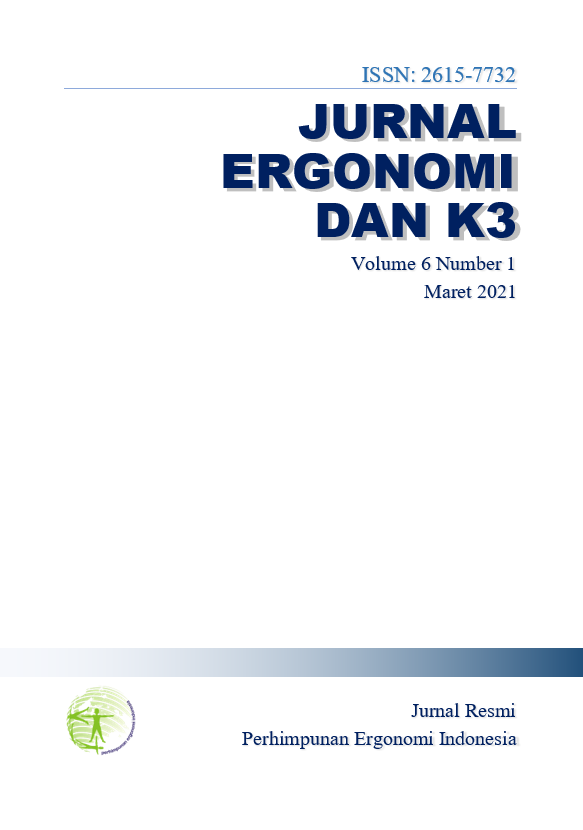The Importance of Ergonomic Work Station Presence at Home during Covid-19 Quarantine in Indonesia
Abstract
Background: Covid-19, which was declared by the WHO as a global pandemic on March 11, 2020, quickly change our way of life. Working from home becomes our new way of work to limit the virus spread. This study aims to present the musculoskeletal complaints by the workers and students, understand the related factors, and propose the ergonomic work station design to reduce the complaints. Methods: We spread the standardized Nordic Questionnaire through google form randomly. The 104 participants living in Indonesia participate in this study. We interview them about the work station they used at home. The questions about the perception of a “good” working position also asked. The logistic regression risk factor model was used to understand the significance of variables. Results: 42 % of respondents do not use chairs and only sit on the floor when working at home. 39.4 % of respondents work 4-6 hours/day. 67.3 % of respondents have musculoskeletal complaints, mostly felt in the neck (54 %). There was no association between the variables. Conclusion: We strongly argue that the ergonomic work station must be implemented at home during the Covid-19 quarantine in Indonesia.References
Ashraf A. Shikdar, Mahmoud A. Al-Kindi. Office Ergonomics: Deficiencies in Computer Workstation Design, International Journal of Occupational Safety and Ergonomics, 13:2, 215-223, DOI: 10.1080/10803548.2007.11076722. 2007.
CDC. Hierarchy of Controls. Available from: https://www.cdc.gov/niosh/topics/hierarchy/default.html (Accessed 9 September 2020). 2020.
CDC. Work-Related Musculoskeletal Disorders & Ergonomics. Available from: https://www.cdc.gov/workplacehealthpromotion/health-strategies/musculoskeletal-disorders/index.html#:~:text=Musculoskeletal%20disorders%20(MSD)%20are%20injuries,to%20the%20condition%3B%20and%2For (9 September 2020). 2020.
Cucinotta D, Vanelli M. WHO Declares COVID-19 a Pandemic. Acta Bio Med (Internet). 2020. 2020 Mar.19 (cited 2020 Aug.20);91(1):157-60. Available from: https://www.mattioli1885journals.com/index.php/actabiomedica/article/view/9397
Felstead and Henseke. Assessing the Growth of Remote Working and Its Consequences for Effort, Well- being and Work- life Balance. New Technology, Work, and Employment. 2017
Guan W, Ni Z, Hu Y, et al. Clinical Characteristics of Coronavirus Disease 2019 in China. N Engl J Med. 2020; 382(18):1708–1720.
Iftikar Zahedi Sutalaksana, Ari Widyanti. Anthropometry Approach in Workplace Redesign in Indonesian Sundanese Roof Tile Industries International Journal of Industrial Ergonomics. 2016
Kushwaha, D.K., Kane, P.V. Ergonomic Assessment and Workstation Design of Shipping Crane Cabin in Steel Industry, International Journal of Industrial Ergonomics, http://dx.doi.org/10.1016/j.ergon.2015.08.003
Lawrence Green, Marshall Kreuter. Health Promotion Planning. An Educational and Environmental Approach. London: Toronto–Mayfield. 1991.
P. Vink & M. A. J. Kompier. Improving Office Work: A Participatory Ergonomic Experiment in A Naturalistic Setting, Ergonomics, 40:4, 435-449, DOI: 10.1080/001401397188071. 1997.
S. Celik, K. Celik, E. Dirimese, et al. “Determination of Pain in Musculoskeletal System Reported by Office Workers and The Pain Risk Factors,” Int. J. Occup. Med. Environ. Health, vol. 31, no. 1, pp. 91–111, 2018.
Sharifi Z, Osqueizadeh R, Tabatabai Ghomshe S F. Ergonomic Redesign of Industrial Chair. Iran J Ergon; 3 (1) :1-9. 2015
WHO. Transmission of SARS-CoV-2: Implications for Infection Prevention Precautions. 2020; ((cited 2020 August 20). Available from: https://www.who.int/news-room/commentaries/detail/transmission-of-sars-cov-2-implications-for-infection-prevention-precautions

